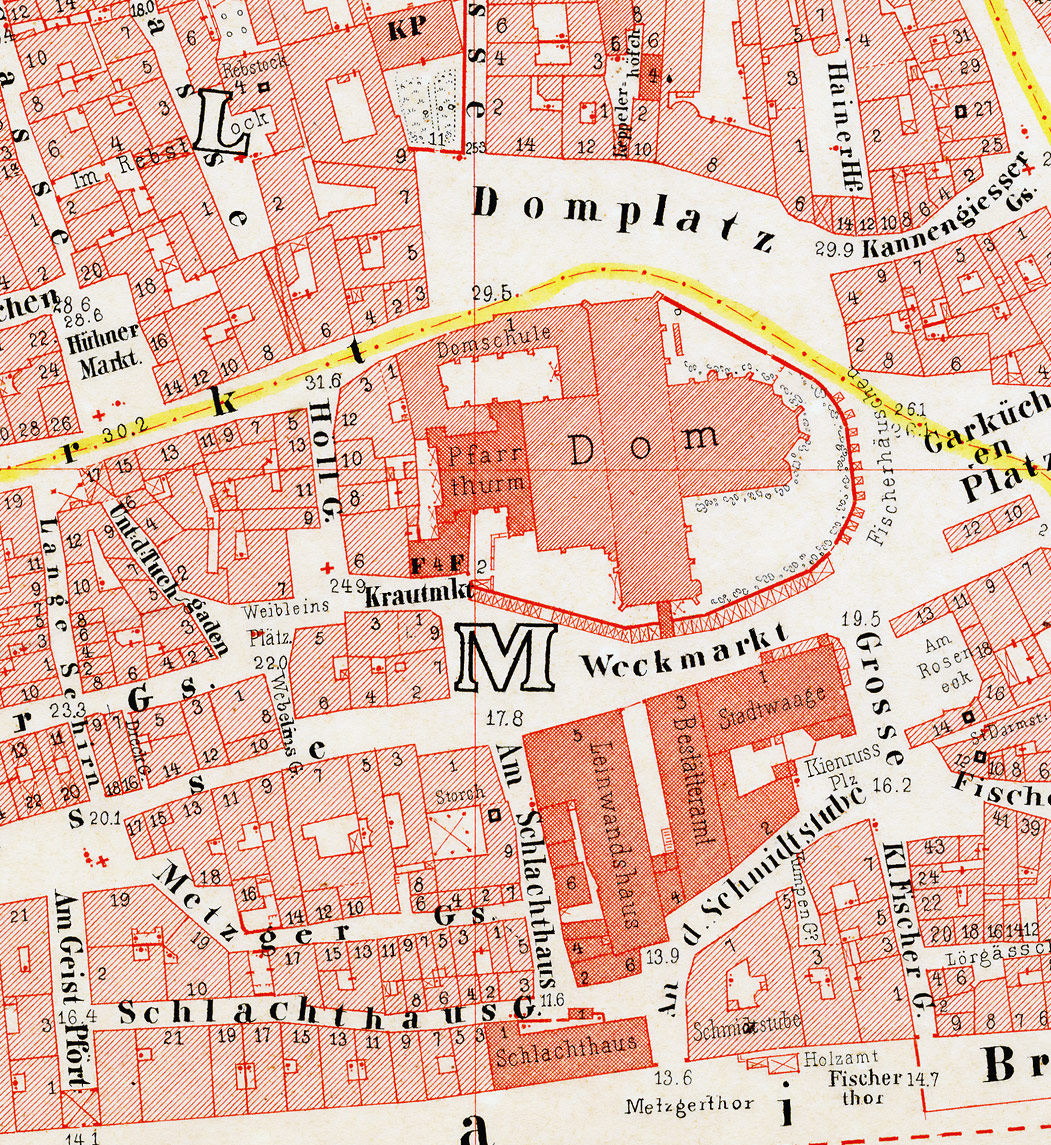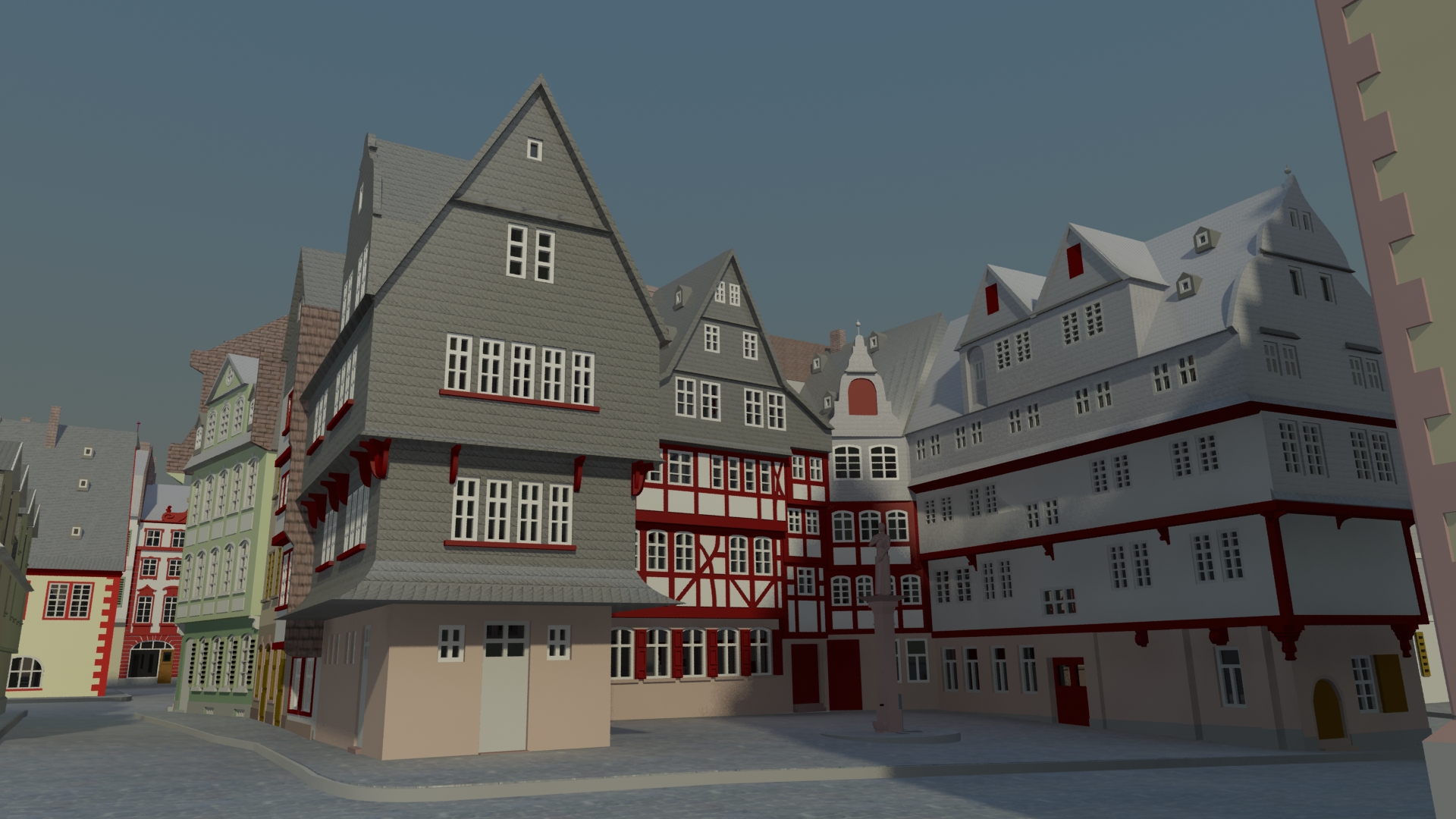Roseneck (Frankfurt am Main) on:
[Wikipedia]
[Google]
[Amazon]
The Roseneck was a group of
 The ''Roseneck'' platz was a small square south of St. Bartholomew's imperial cathedral. It was on the east side of a small street named ''Große Fischergasse'', which branched off to the south between ''Garküchenplatz'' in the east and ''Weckmarkt'' in the west as can be seen on the 1861 map. To the west of the Roseneck was the Stadtwaage, which was demolished in 1873 and replaced by a
The ''Roseneck'' platz was a small square south of St. Bartholomew's imperial cathedral. It was on the east side of a small street named ''Große Fischergasse'', which branched off to the south between ''Garküchenplatz'' in the east and ''Weckmarkt'' in the west as can be seen on the 1861 map. To the west of the Roseneck was the Stadtwaage, which was demolished in 1873 and replaced by a
 The Roseneck was in the first Jewish residential area. After the small Jewish community, consisting of around 60 people, fell victim to the pogrom of 1349, the city council confiscated the properties and gave them to new owners. The ''Lörhof'' or ''Curia Cerdonum was'' built on the square at the Roseneck, a courtyard consisting of several buildings that could be closed by gates to the surrounding streets. The courtyard belonged to the Lohgerber guild, but soon was sold to private individuals. The courtyard was later divided and compacted by several small houses. In the first half of the 16th century, the council had some of the houses demolished to make more living space for everyone. Thus, the Roseneck square was created.
The houses corresponded to typical Frankfurt construction with a ground floor made of sandstone and two to three half-timbered upper floors, whose overhangs were supported by decorated sandstone
The Roseneck was in the first Jewish residential area. After the small Jewish community, consisting of around 60 people, fell victim to the pogrom of 1349, the city council confiscated the properties and gave them to new owners. The ''Lörhof'' or ''Curia Cerdonum was'' built on the square at the Roseneck, a courtyard consisting of several buildings that could be closed by gates to the surrounding streets. The courtyard belonged to the Lohgerber guild, but soon was sold to private individuals. The courtyard was later divided and compacted by several small houses. In the first half of the 16th century, the council had some of the houses demolished to make more living space for everyone. Thus, the Roseneck square was created.
The houses corresponded to typical Frankfurt construction with a ground floor made of sandstone and two to three half-timbered upper floors, whose overhangs were supported by decorated sandstone 
half-timbered
Timber framing (german: Holzfachwerk) and "post-and-beam" construction are traditional methods of building with heavy timbers, creating structures using squared-off and carefully fitted and joined timbers with joints secured by large wooden ...
houses in Frankfurt am Main
Frankfurt, officially Frankfurt am Main (; Hessian: , "Frank ford on the Main"), is the most populous city in the German state of Hesse. Its 791,000 inhabitants as of 2022 make it the fifth-most populous city in Germany. Located on its na ...
. The small square was a tourist attraction and, alongside the Five-Finger Square, was one of the most popular postcard motifs in the picturesque old town (altstadt) of Frankfurt. The Roseneck was destroyed in the air raids on Frankfurt in 1944. When it was rebuilt in 1952, the properties and alleys of the ensemble were redesigned with simple residential and commercial buildings.
Location
 The ''Roseneck'' platz was a small square south of St. Bartholomew's imperial cathedral. It was on the east side of a small street named ''Große Fischergasse'', which branched off to the south between ''Garküchenplatz'' in the east and ''Weckmarkt'' in the west as can be seen on the 1861 map. To the west of the Roseneck was the Stadtwaage, which was demolished in 1873 and replaced by a
The ''Roseneck'' platz was a small square south of St. Bartholomew's imperial cathedral. It was on the east side of a small street named ''Große Fischergasse'', which branched off to the south between ''Garküchenplatz'' in the east and ''Weckmarkt'' in the west as can be seen on the 1861 map. To the west of the Roseneck was the Stadtwaage, which was demolished in 1873 and replaced by a neo-Gothic
Gothic Revival (also referred to as Victorian Gothic, neo-Gothic, or Gothick) is an architectural movement that began in the late 1740s in England. The movement gained momentum and expanded in the first half of the 19th century, as increasingly ...
building housing the city archives. On the southern edge of the square, Große Fischergasse bent east.
History
 The Roseneck was in the first Jewish residential area. After the small Jewish community, consisting of around 60 people, fell victim to the pogrom of 1349, the city council confiscated the properties and gave them to new owners. The ''Lörhof'' or ''Curia Cerdonum was'' built on the square at the Roseneck, a courtyard consisting of several buildings that could be closed by gates to the surrounding streets. The courtyard belonged to the Lohgerber guild, but soon was sold to private individuals. The courtyard was later divided and compacted by several small houses. In the first half of the 16th century, the council had some of the houses demolished to make more living space for everyone. Thus, the Roseneck square was created.
The houses corresponded to typical Frankfurt construction with a ground floor made of sandstone and two to three half-timbered upper floors, whose overhangs were supported by decorated sandstone
The Roseneck was in the first Jewish residential area. After the small Jewish community, consisting of around 60 people, fell victim to the pogrom of 1349, the city council confiscated the properties and gave them to new owners. The ''Lörhof'' or ''Curia Cerdonum was'' built on the square at the Roseneck, a courtyard consisting of several buildings that could be closed by gates to the surrounding streets. The courtyard belonged to the Lohgerber guild, but soon was sold to private individuals. The courtyard was later divided and compacted by several small houses. In the first half of the 16th century, the council had some of the houses demolished to make more living space for everyone. Thus, the Roseneck square was created.
The houses corresponded to typical Frankfurt construction with a ground floor made of sandstone and two to three half-timbered upper floors, whose overhangs were supported by decorated sandstone cantilever
A cantilever is a rigid structural element that extends horizontally and is supported at only one end. Typically it extends from a flat vertical surface such as a wall, to which it must be firmly attached. Like other structural elements, a canti ...
stones. The steep gable
A gable is the generally triangular portion of a wall between the edges of intersecting roof pitches. The shape of the gable and how it is detailed depends on the structural system used, which reflects climate, material availability, and aesth ...
roofs carried one or more dwarf houses with pointed gables or wave gables. The facades of the houses were originally slated or plastered. The houses were already used for gastronomy in the 19th century. In 1902 the facade of one of the houses was painted in the folk style. The wall paintings disappeared again when, in the course of the restoration of the old town'','' the houses were renovated in 1929 with the half-timbering partially exposed.

Destruction
After the first serious damage in an air raid on January 29, 1944, the half-timbered houses in the attack on March 18 and 22, 1944 burned out completely. After the war, the debris was removed from the 1950's. Rebuilding began in 1952, when the old plots and streets were completely changed. Today nothing resembles the Roseneck in the cityscape. In addition to old photographs, films and paintings, Treuner's old town model and the virtual old town model by Jörg Ott preserve the memory of the Roseneck.Literature
* Johann Georg Battonn: ''Local Description of the City of Frankfurt am Main – Volume III.'' Association for History and Antiquity Studies in Frankfurt am Main, Frankfurt am Main 1863, pp. 340–341 () * Johann Georg Battonn: ''Local Description of the City of Frankfurt am Main – Volume IV.'' Association for History and Ancient History of Frankfurt am Main, Frankfurt am Main 1864, pp. 9–10 () * Heinrich Voelcker, ''the old town in Frankfurt am Main within the Hohenstaufen Wall''. Frankfurt am Main 1937, Moritz Diesterweg publishing house * Georg Hartmann, Fried Lübbecke: ''Old Frankfurt. A legacy''. Verlag Sauer and Auvermann, Glashütten 1971 * Hartwig Beseler, Niels Gutschow: The ''fate of war in German architecture – losses, damage, reconstruction''. Karl Wachholtz Verlag, Neumünster 1988, * Wolfgang Klötzer: ''A guest in old Frankfurt''. Hugendubel, Munich 1990, , pp. 52–55References